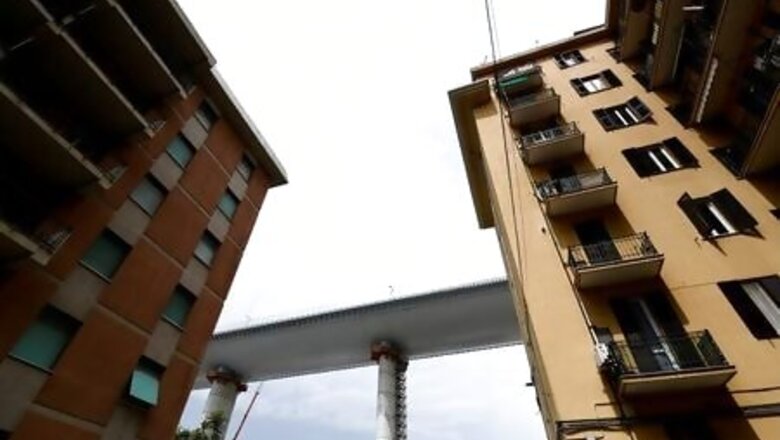
views
MILAN Italy opened a new motorway bridge in the northern city of Genoa on Monday, hailing a new beginning two years after the previous structure collapsed, killing 43 people, in one of the country’s worst civil disasters in decades.
The new Genova-San Giorgio bridge, designed by star architect Renzo Piano, replaces the old span that broke apart on Aug. 14, 2018, laying bare the derelict state of large parts of Italy’s road infrastructure.
“Genoa is the sign that Italy is able to rise again and can restart to run,” Prime Minister Giuseppe Conte said at a ceremony attended by President Sergio Mattarella but boycotted by many of the victims’ families, who feared the inauguration would turn into a celebration.
In a speech at the event, Piano said he had conceived the bridge and its elliptical 40-metre high pillars as a ship to catch the Mediterranean light.
“This bridge is simple and strong as this city and plays with the light and the wind,” he said.
The opening coincides with a still-unfinished battle over the accident itself, which came after years of mismanagement and poor maintenance under Autostrade per l’Italia, the private concession holder controlled by the powerful Benetton family that ran the bridge.
Several officials from Autostrade, a unit of infrastructure group Atlantia, and the transport ministry have been placed under investigation by prosecutors.
“There’s a feeling of both regret for what happened and pride in the work that’s been done,” said Marco Bucci, the mayor of Genoa who was appointed as special commissioner to oversee the project. “We’ve worked and shown Italian excellence.”
For years, Italy’s economy has suffocated under a mix of poor governance, corruption, vested interests and bureaucracy that have stifled innovation and fostered the kind of neglect that led to the bridge disaster.
With the coronavirus crisis still unfolding and billions of euros set to come to Italy from Europe’s newly agreed recovery fund, addressing such failures has gained a new urgency.
In stark contrast to the neglect that led to the disaster, the new bridge was completed at breakneck speed, with work continuing uninterrupted despite the COVID epidemic and the opening taking place less than 18 months after the remainder of the old structure was demolished in February 2019.
With billions of euros set to come to Italy from EU recovery funds, a lot rides on repeating that momentum elsewhere.
“We need to export this immediately because Italy needs infrastructure, we need to do it,” said Pietro Salini, chief executive of Webuild, formerly Salini Impregilo, one of the main partners along with infrastructure group Fincantieri, of the Pergenova consortium which built the bridge.
As well as the human toll, the collapse of the Morandi bridge dealt a severe economic blow to Genoa, costing the city about 6 million euros ($7 million) a day in lost revenues and additional costs, with freight traffic interrupted for months.
(Editing by Alexandra Hudson, John Stonestreet, Giles Elgood and Nick Macfie)
Disclaimer: This post has been auto-published from an agency feed without any modifications to the text and has not been reviewed by an editor



















Comments
0 comment